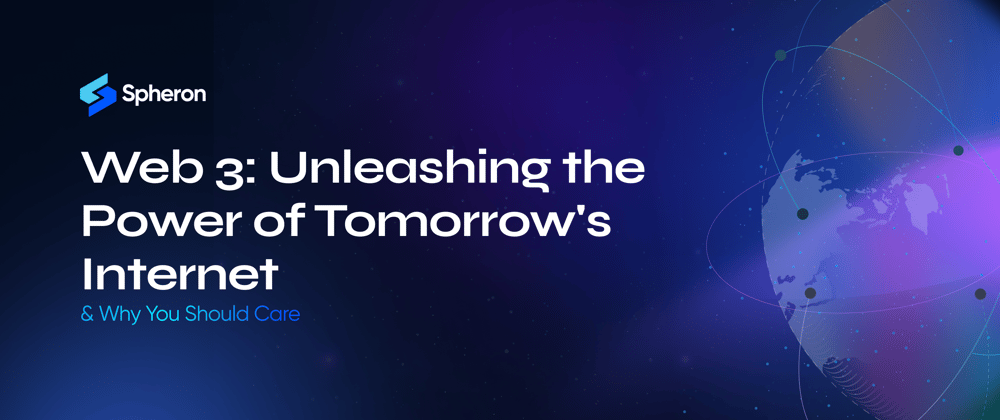Introduction
The evolution of the Internet has been an incredible journey, from the early days of Web 1.0 to the transformative era of Web 2.0. In the beginning, Web 1.0 was the early phase of the Internet, where it served as a vast repository of information with limited access to content creation.
Web 2.0 brought about a significant shift by democratizing content creation, allowing anyone to share their ideas and creations through user-generated content on social media platforms. Platforms like Facebook, Twitter, and YouTube emerged as the champions of this new era, fueled by user-generated content.
But now, a new horizon awaits us: Web 3.0 . With Web 3.0, we are poised to witness a paradigm shift that promises to redefine the very fabric of the Internet. It goes beyond content creation and user participation_Where the power to shape the Internet lies in your hands._
What is Web 3.0? Why is it important?
Imagine you create a thought-provoking video discussing a topic, expressing opinions, or sharing viewpoints and upload it on YouTube, Twitter, or Facebook. And your video gets flagged and taken down without your consent for some reason. There have been cases In this scenario already happened, you lose control over your own content, and the decision to remove it lies solely in the hands of the platform.
Similarly, Twitter and Facebook have faced criticism for suspending or banning users based on their viewpoints, leading to accusations of political bias and suppression of diverse voices. This has raised concerns about the limitation of free expression and the centralized control these platforms hold over user content.
Web3 offers a potential solution to these challenges. By leveraging blockchain technology and decentralized platforms, Web 3.0 aims to empower users with more control and freedom over their content. Imagine a future where you can upload your videos, share your thoughts, and engage in discussions without the fear of arbitrary censorship or removal.
The decision-making process in a Web 3.0 environment shifts from centralized authorities to decentralized consensus mechanisms. This means that content removal would require broader community agreement or evidence of violating clear, transparent rules established by the community rather than being solely determined by platform guidelines.
The Transformative Benefits of Web3.0
Empowerment and Inclusion: Web 3.0 promotes user empowerment and inclusion by giving individuals greater control over their data and privacy. This shift from centralized control to user-owned data allows people to say how their information is used and shared.
Economic Opportunities and Innovation: Web 3.0 opens new economic growth and innovation avenues. The decentralized nature of Web 3.0 eliminates the need for intermediaries, reducing transaction costs and enabling peer-to-peer transactions. This can empower individuals and small businesses, particularly in developing countries, to participate in global markets, access financial services, and participate in digital infrastructure.
Transparent Governance: Web 3.0 introduces decentralized governance models where decision-making is distributed among participants. This fosters transparency, accountability and reduces corruption by allowing individuals to participate directly in decision-making processes that affect them, empowering communities to have a more significant say in shaping policies and regulations.
Trust and Security: Web 3.0 leverages blockchain technology to enhance trust and security in online transactions. Using decentralized consensus mechanisms and cryptographic algorithms ensure the integrity and immutability of data, reducing the risk of fraud and unauthorized access. Increased trust and security enable individuals and organizations to confidently engage in online activities, leading to more widespread adoption of digital services and e-commerce.
Resilience and Anti-Censorship: Web 3.0 is designed to resist censorship and single points of failure. By leveraging decentralized networks and protocols, it reduces the vulnerability of information and services to censorship or shutdowns. This can be particularly beneficial in regions where freedom of expression and access to information are restricted, allowing individuals to freely exercise their rights and connect with the global community.
Collaboration and Knowledge Sharing: Web 3.0 allows different platforms and apps to work together smoothly, making it easier for people to communicate and share knowledge. This means individuals, organizations, and even governments can collaborate more effectively, solving problems and sharing ideas globally.
Cost Optimization: Web 3.0 revolutionizes global collaboration and knowledge sharing by optimizing costs. It enables seamless communication and collaboration across borders, eliminating the need for expensive travel and infrastructure. Organizations can leverage real-time virtual meetings, decentralized networks, and affordable access to knowledge and expertise, reducing expenses and enhancing resource allocation. This cost optimization fosters cross-cultural understanding, accelerates innovation, and fuels collective global problem-solving.
Conclusion
Web 3.0 goes beyond mere money earning and ventures into reshaping the core principles of the digital realm. It promises to transform the original vision of the Internet as we know it, driven by its focus on redefining ownership and control, enhancing privacy and security, and fostering economic opportunities and inclusivity on a global scale. Web3's potential impact is far-reaching, with the power to reshape our online experiences, empower individuals with ownership and control over their data, and create a more secure and private digital environment.







Top comments (0)